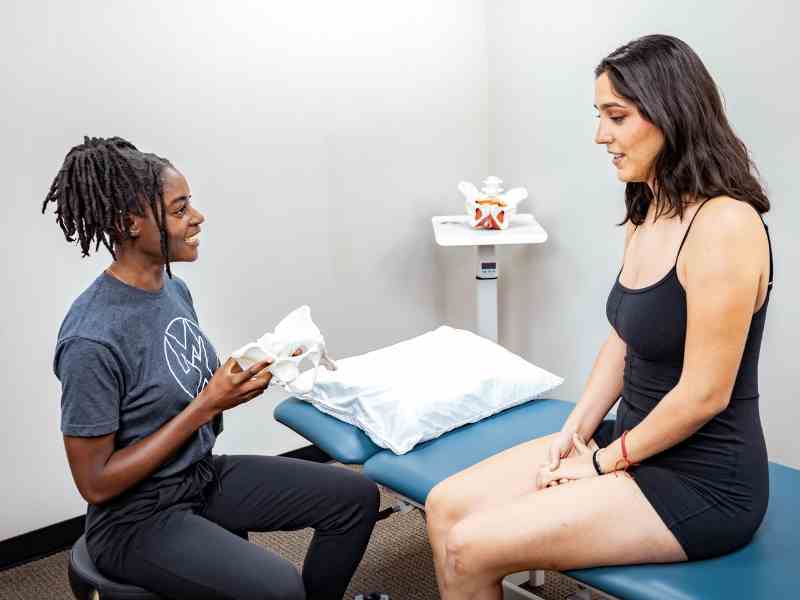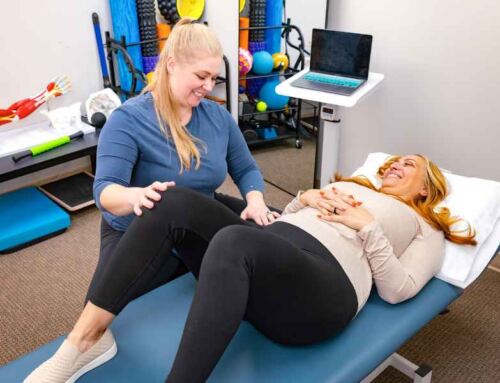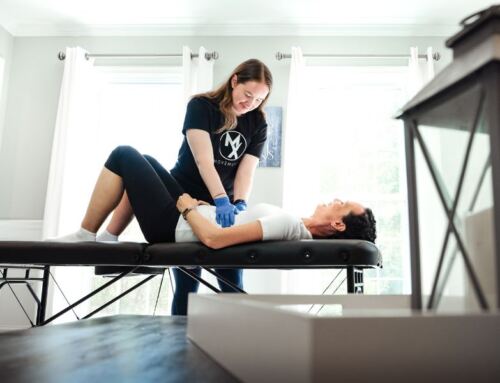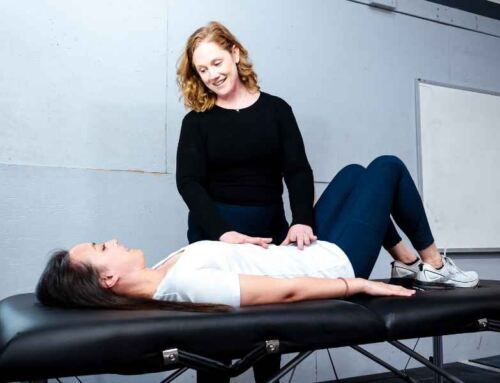For many people, chronic pelvic pain (CPP) is an invisible disability, one that’s often misunderstood, minimized, or misdiagnosed. The pain may not be visible, but it deeply affects how people move, relate, and exist in their own bodies.
What makes chronic pelvic pain so complex is that it often carries the echo of past experiences.
Trauma (whether physical, emotional, sexual, verbal, or medical) can leave an imprint that the body remembers long after the event itself has passed. As Bessel van der Kolk explains in The Body Keeps the Score, our bodies store these memories as protective patterns, even when we’re not consciously aware of them. Over time, those protective responses can become the very source of our pain.
Living in a State of Protection
For individuals with chronic pelvic pain, the nervous system is often stuck in overdrive. The sympathetic nervous system, responsible for “fight, flight, or freeze,” becomes the dominant mode of operation. Meanwhile, the parasympathetic system (our “rest and digest” state) can be nearly impossible to access.
This imbalance creates a loop that feeds itself: pain increases tension, tension heightens the sense of danger, and the body doubles down on its protective stance. The pelvic floor muscles, in particular, play a key role in this cycle. Research shows that these muscles automatically contract first in response to threat or discomfort, often without our conscious control (Birth in Motion, 2022).
While this reaction once served as a means of protection, chronic contraction over time can cause pain, urinary or bowel dysfunction, and sexual health issues. A study published in the European Journal of Psychotraumatology found that women with trauma histories and PTSD symptoms often demonstrate higher pelvic floor muscle activity and more sexual dysfunction (Karsten et al., 2020).
It’s not just the pelvic floor muscles that react this way. The entire body can adopt patterns of guarding and bracing, as if waiting for something bad to happen. Muscles stay tense, breathing becomes shallow, and movement feels restricted. The result is a self-perpetuating pain loop that can be incredibly difficult to break.

The Emotional Weight of Chronic Pain
Beyond the physical, living with chronic pain has deep psychological effects. Depression and anxiety are common among people with CPP, with rates significantly higher than the general population (Neto et al., 2025). The loss of mobility and participation in daily life (sports, hobbies, intimacy) can leave individuals feeling disconnected and discouraged and further perpetuate this vicious cycle.
As one 2024 study described it, many women with pelvic pain experience both post-traumatic stress and post-traumatic growth, learning to rebuild their sense of safety and identity even as they navigate daily discomfort (Wall et al., 2024).
When untreated, the chronic activation of the nervous system affects far more than pain mechanisms. It can alter digestion, sleep, immune function, and emotional regulation. Over time, this constant state of defense wears the body down—a process known as weathering. This phenomenon is especially prevalent in marginalized populations (minorities, women, children, and gender-expansive folks) who often experience ongoing systemic and interpersonal stress (SAMHSA, 2014) related to who they are as human beings.
Breaking the Cycle: A Nervous System Approach
To truly help people heal from chronic pelvic pain, we must address both the physical and the emotional components of trauma. That’s where pelvic health physical therapy (PT) comes in.
Pelvic PTs specialize in understanding how the nervous system, muscles, and connective tissues interact. Treatment often begins by determining which direction to address healing from: a top-down or bottom-up approach.
- A top-down approach starts with calming the nervous system through mindfulness-based cognitive strategies such as meditation, visualization, and guided relaxation. These interventions help retrain the brain to interpret sensations differently and reduce the “threat” signals that perpetuate pain (ScienceDirect, 2000). It emphasizes approaching pain from a non-judgement lens…much easier said than done.
- A bottom-up approach begins with gentle physical interventions such as diaphragmatic breathing, manual therapy, stretching, vibration therapy, or cupping to reduce tension and improve circulation. Movement and exercise help strengthen weak areas and release the constant muscle guarding that drives discomfort (Physio-Pedia, Integrative Approaches for Pelvic Pain in Trauma Recovery).
For some, it’s best to start from the mind; for others, the body is the safest entry point. Often, both are needed to achieve lasting change. As these folks begin to engage in activities they haven’t been able to previously, you start to witness healing from not only a physical perspective, but mental and emotional as well.
The key to this approach is personalization: meeting each patient exactly where they are.

The Value of Interdisciplinary Care
Because trauma is multidimensional, recovery works best when care is interdisciplinary. Pelvic PTs frequently collaborate with mental health therapists, physicians, and other providers to address the full biopsychosocial picture.
Research has linked trauma histories not only to pelvic pain, but also to conditions like irritable bowel syndrome (IBS), where somatization—expressing emotional distress through physical symptoms—plays a central role (White et al., 2010; Schubach et al.). This further underscores the need to treat both mind and body simultaneously.
Trauma-informed frameworks emphasize safety, empowerment, and choice. As Trauma-Informed Care in Behavioral Health Services (SAMHSA, 2014) notes, recovery flourishes when people feel seen, supported, and respected. Not rushed or retraumatized by their care.
Redefining Healing and Autonomy
Healing from chronic pelvic pain doesn’t mean “fixing” the body—it means reconnecting with it.
Through trauma-informed care, patients begin to understand how their pain developed and learn tools to regulate their nervous system. They discover that their symptoms are not signs of weakness, but of resilience; the body doing its best to protect them for years.
Now, they learn how to be in control of these shifts rather than fighting against them. They learn how to lean into these pain signals and allow their awareness to understand the story their body is trying to tell them.
Over time, this awareness leads to:
- Less pain and improved mobility
- Restored balance between the sympathetic and parasympathetic systems
- Improved sexual, bowel, and bladder function
- Greater emotional stability and self-understanding
- A sense of agency and ownership over one’s healing
As van der Kolk reminds us, recovery is not about erasing the past but about reclaiming the present and coming home to one’s body again.

A Compassionate Call to Care
Chronic pelvic pain and trauma are deeply intertwined, and healing them requires patience, compassion, and collaboration. Pelvic health PTs, mental health providers, and patients themselves all play vital roles in this process.
When we center those most affected by trauma and systemic stressors, we raise the standard of care for everyone.
The journey may not be linear, but it is profoundly human. With the right support, people can move beyond survival mode, find comfort in their own bodies, and live with greater freedom and peace.
📚 Keep Learning
Want to keep learning? Check out these resources below.
- The Body Keeps the Score — Bessel van der Kolk, M.D.
- Trauma-Informed Care in Behavioral Health Services (SAMHSA, 2014)
- The Relationship Between Involuntary Pelvic Floor Muscle Activity, Muscle Awareness, and Experienced Threat (2022)
- Sexual Function and Pelvic Floor Activity in Women: The Role of Traumatic Events and PTSD Symptoms (Karsten et al., 2020)
- “It’s a Right Pain in the Pelvis!” Post-Traumatic Stress and Growth in Chronic Pelvic Pain (Wall et al., 2024)
- Prevalence of Depression and Anxiety in Women with Chronic Pelvic Pain (Neto et al., 2025)
- Trauma History and Risk of Irritable Bowel Syndrome in Women Veterans (White et al., 2010)
- Somatization Mediates the Relationship Between Childhood Trauma and Pain Ratings (Schubach et al.)
- Cognitive-Behavioral Models of Chronic Pain (ScienceDirect, 2000)
- Integrative Approaches for Pelvic Pain in Trauma Recovery (Physio-Pedia)
About the Author
Dr. Bridget Ochuko is a physical therapist based in Durham, NC. She treats prenatal and postpartum folks, pregnant and postpartum runners, active young adults, active aging adults, and complex and/or chronic pelvic pain alongside women’s health. Dr. Bridget also prioritizes LGBTQIA+ inclusive care. With a focus on holistic, well-rounded care for everyone, Dr. Bridget is here to help you learn movements and strategies to improve your overall quality of life.








